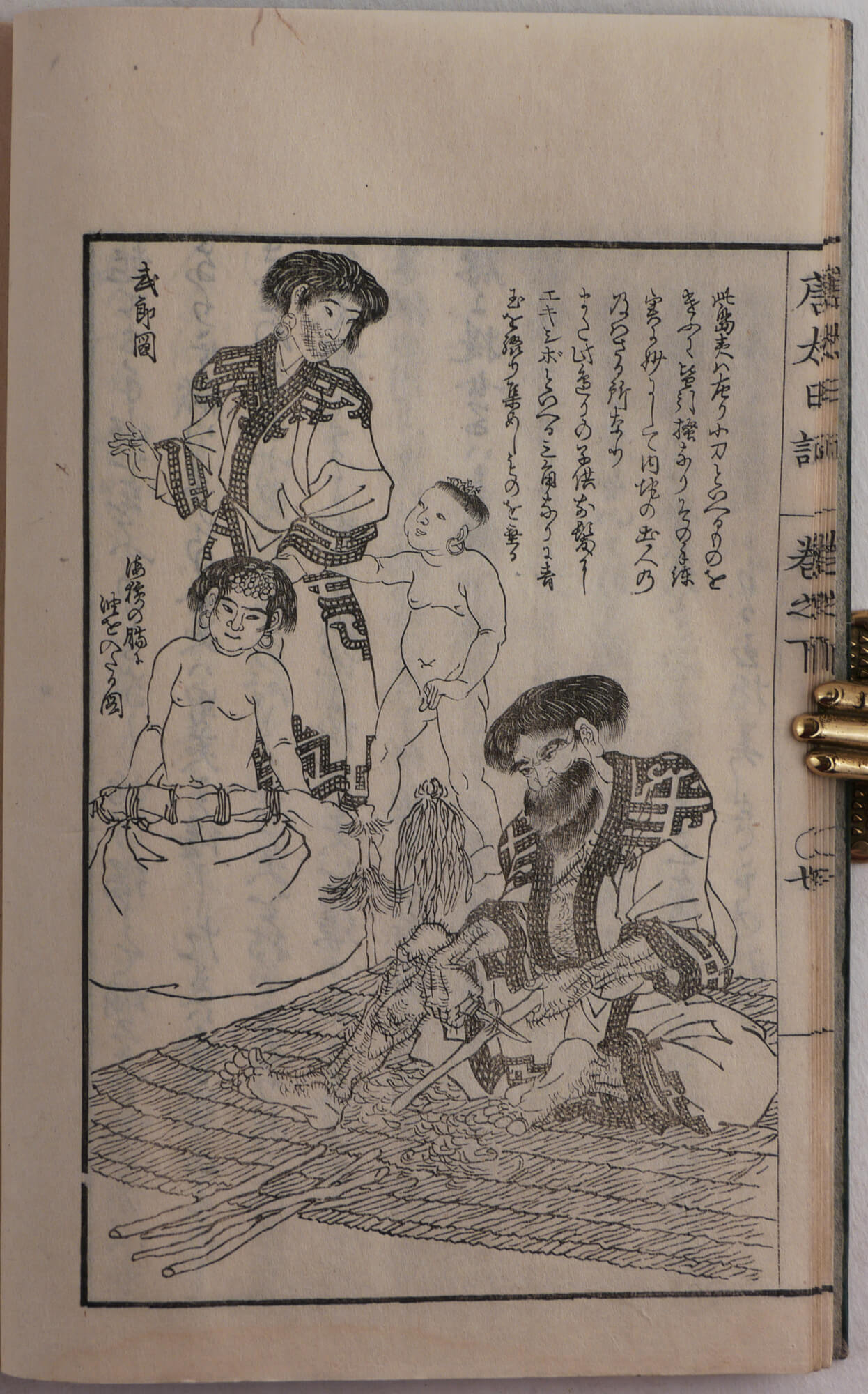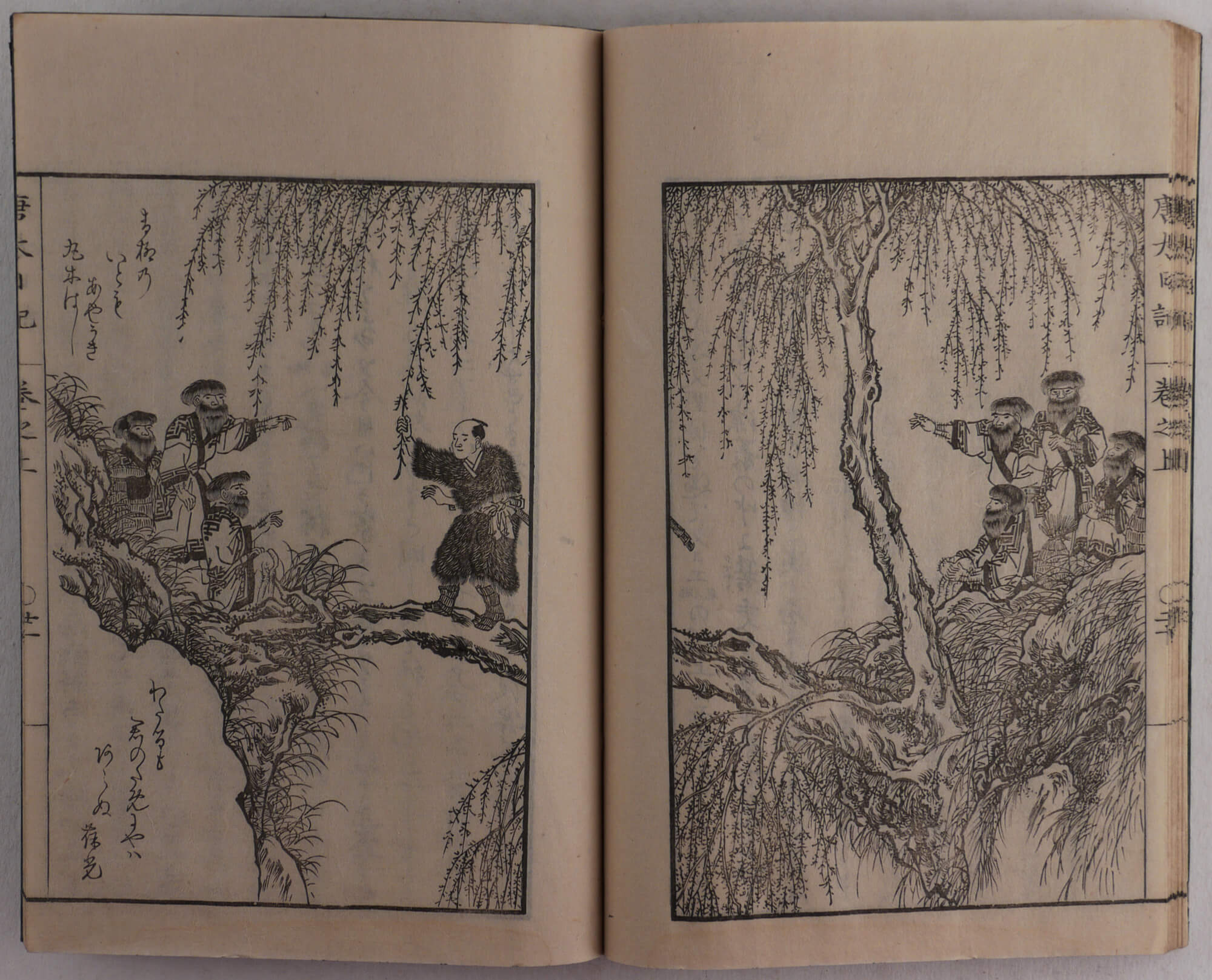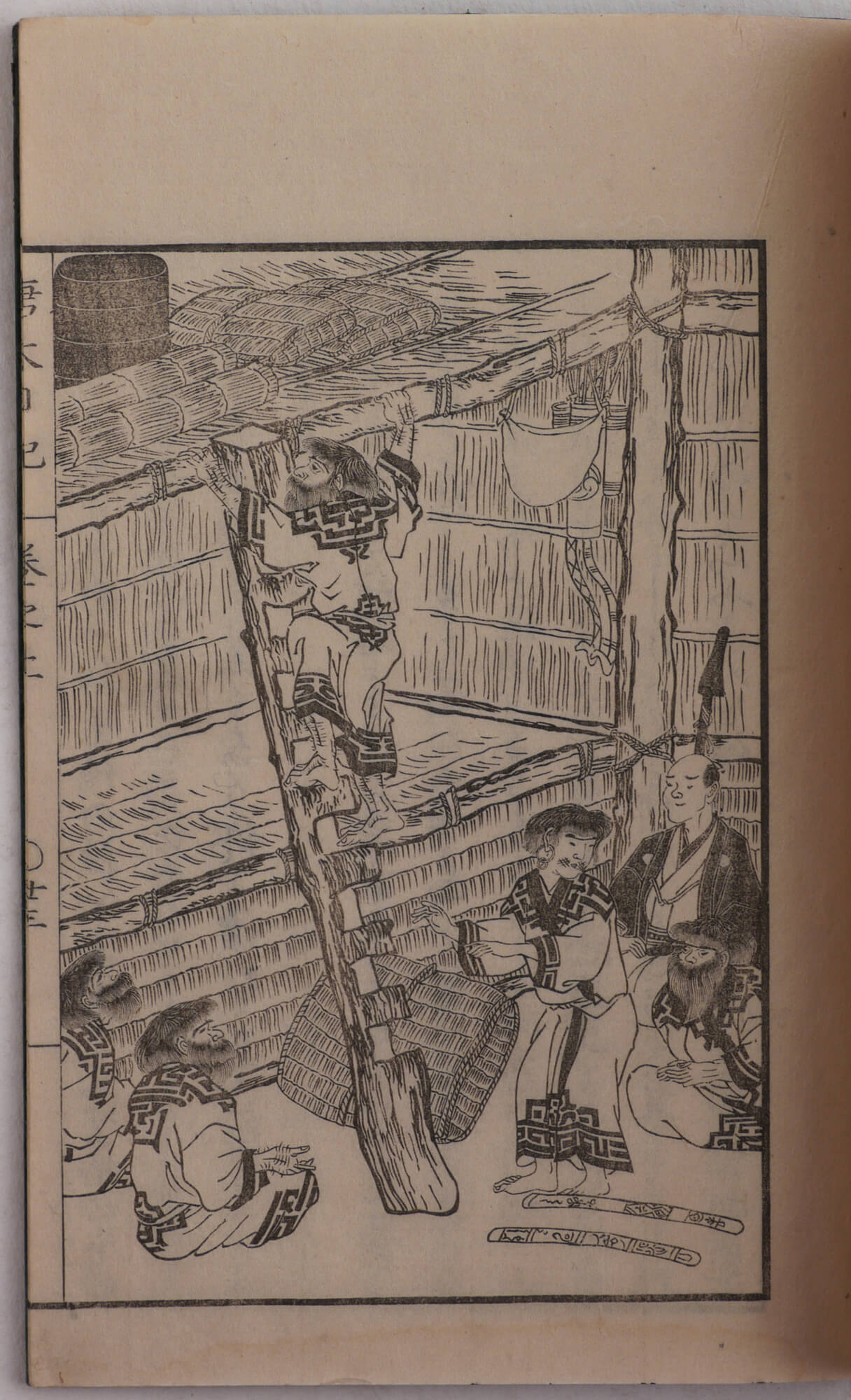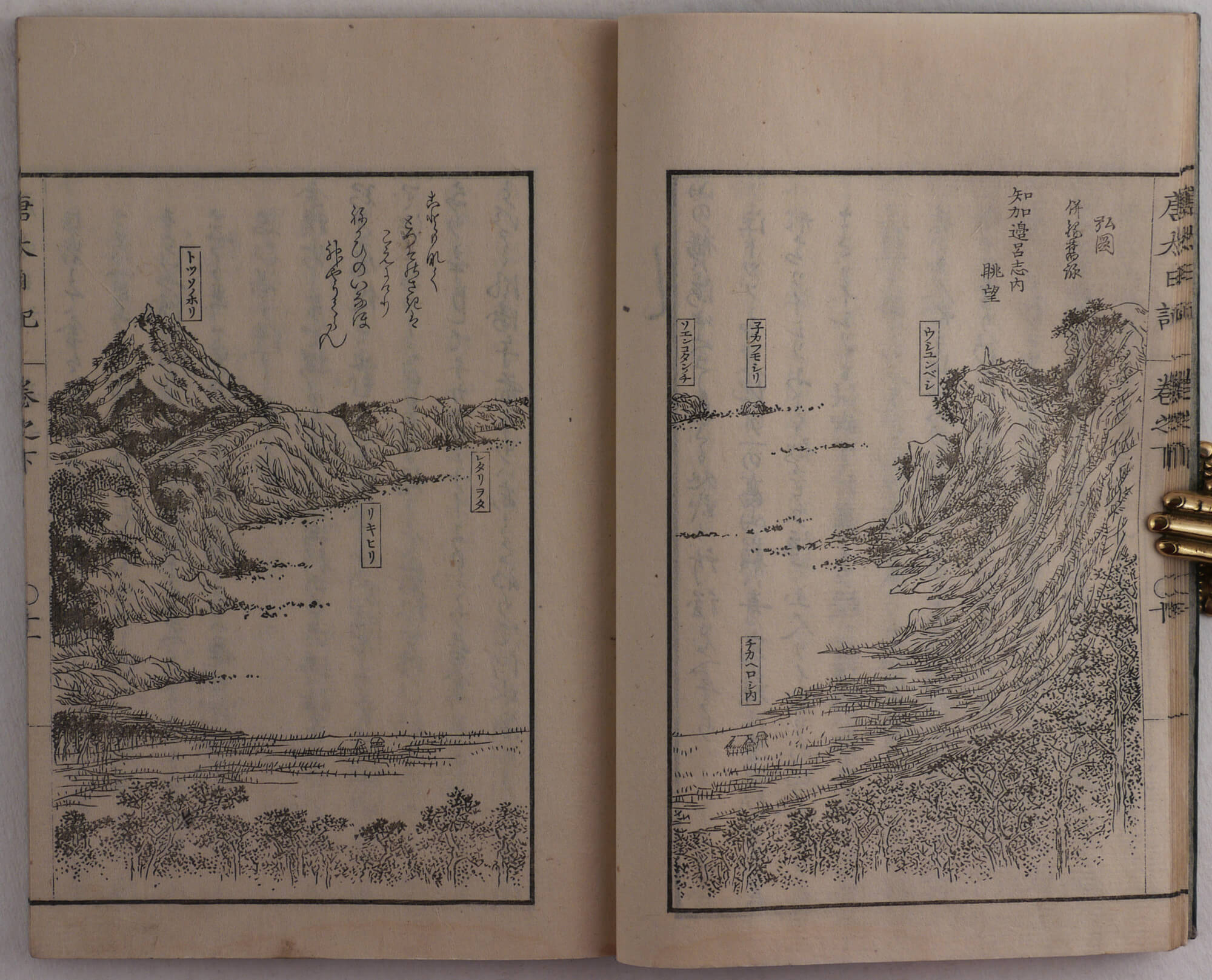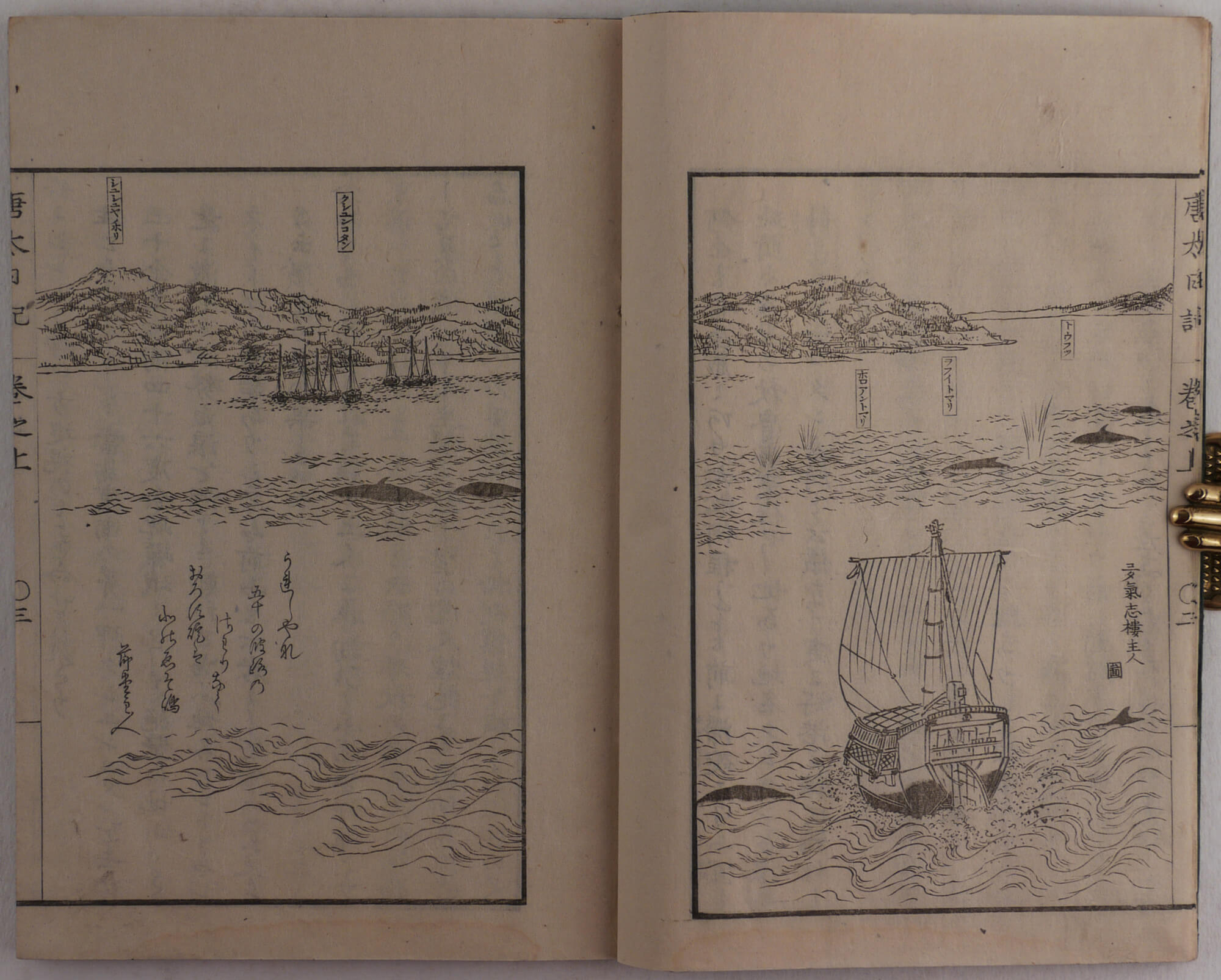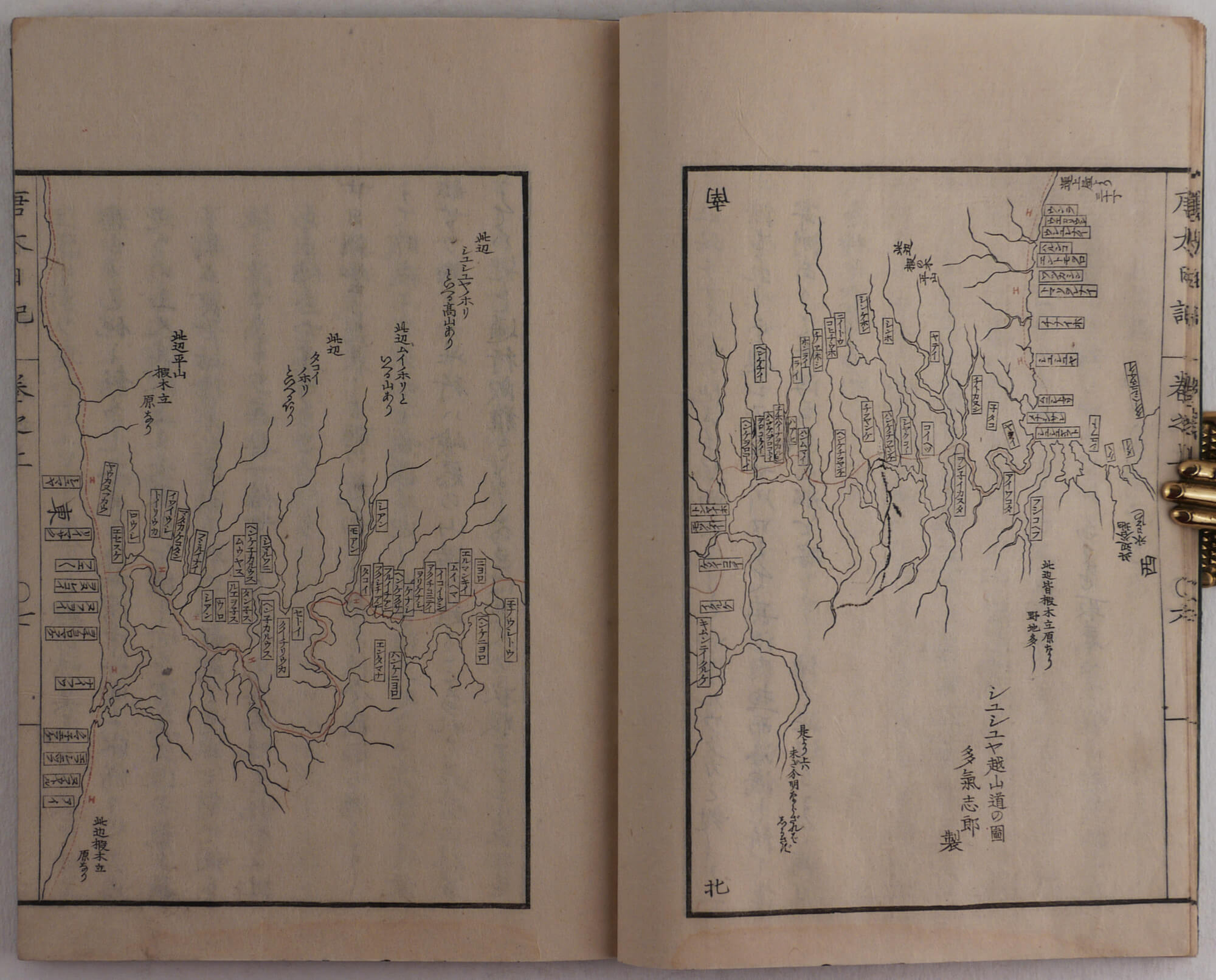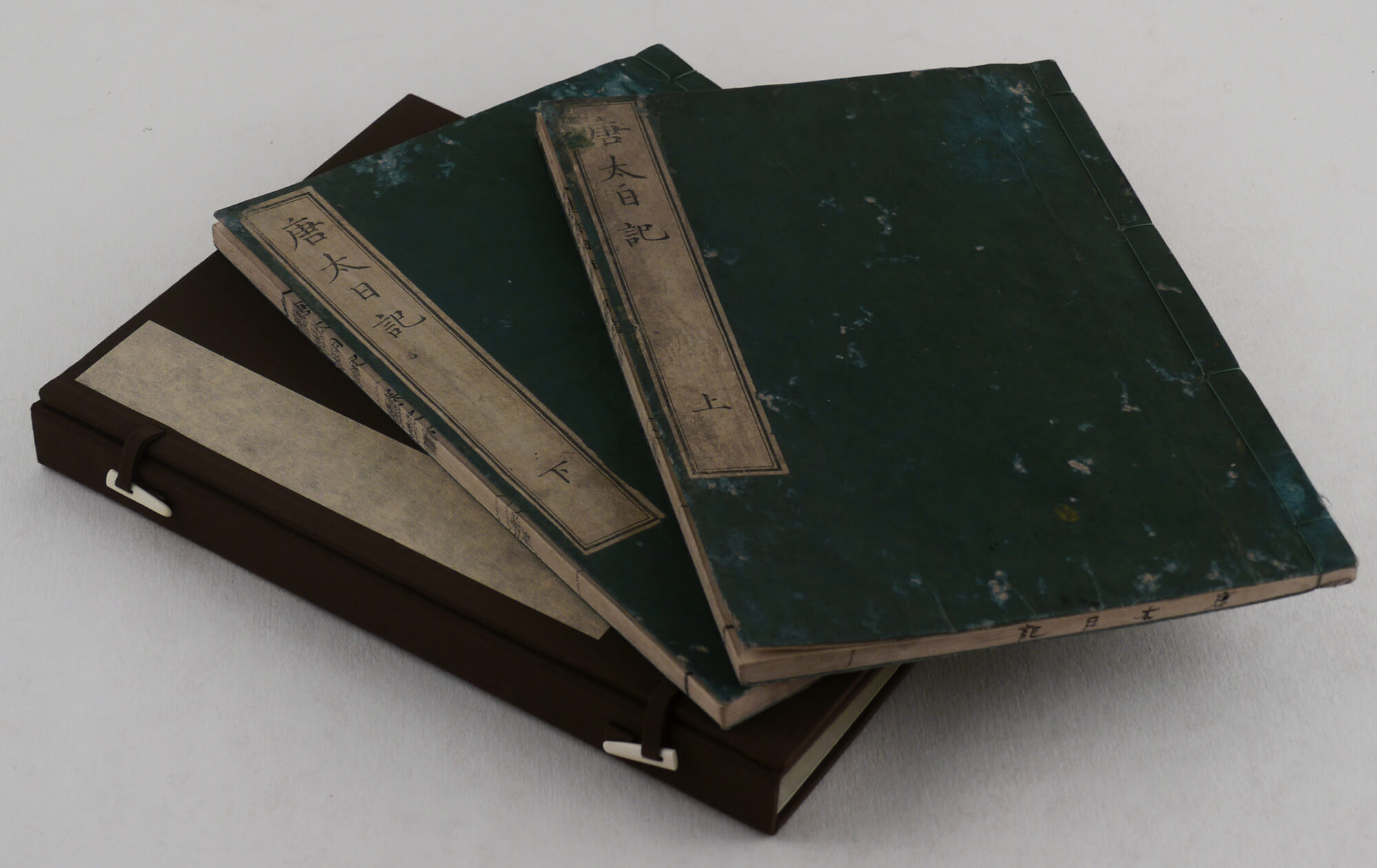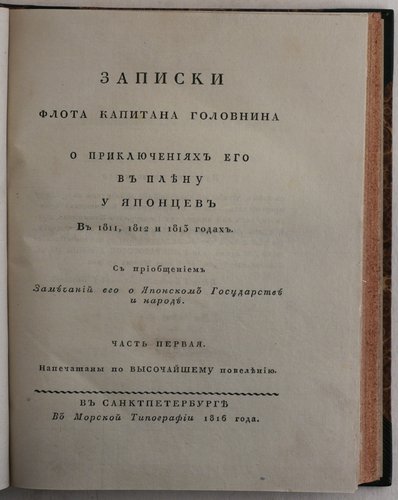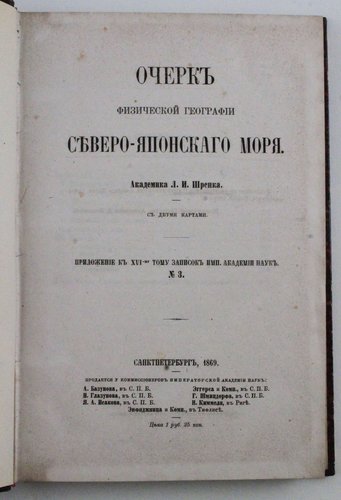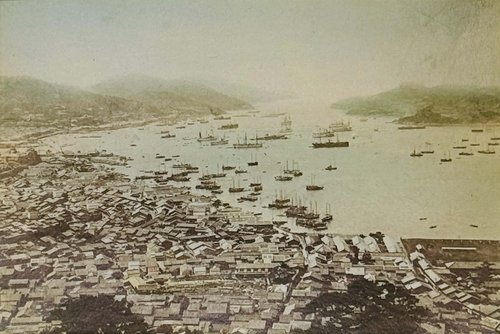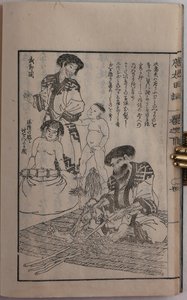
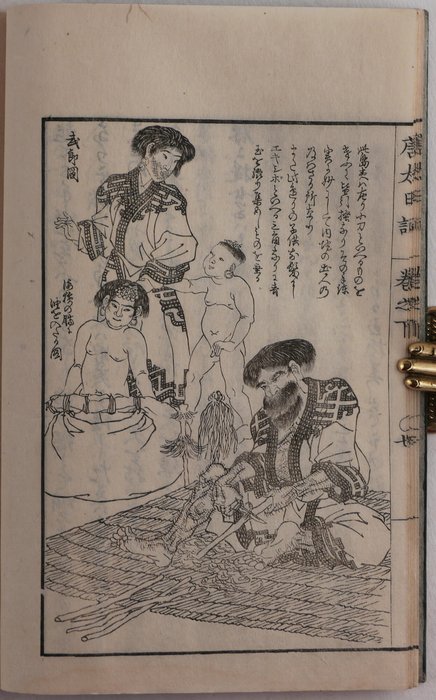
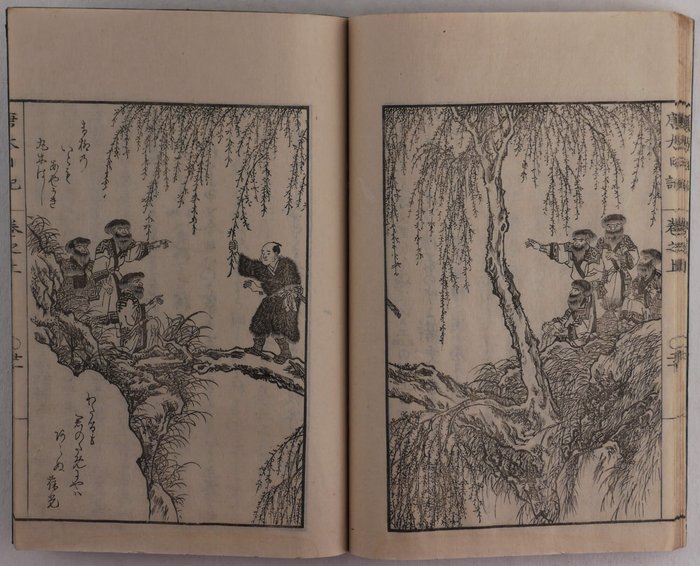
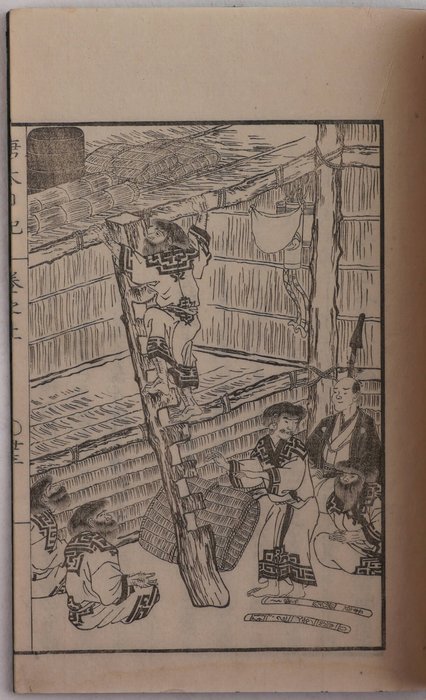
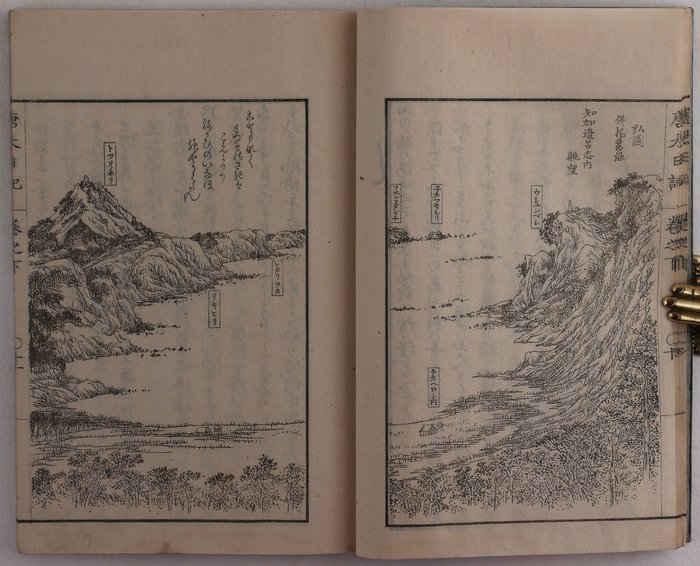
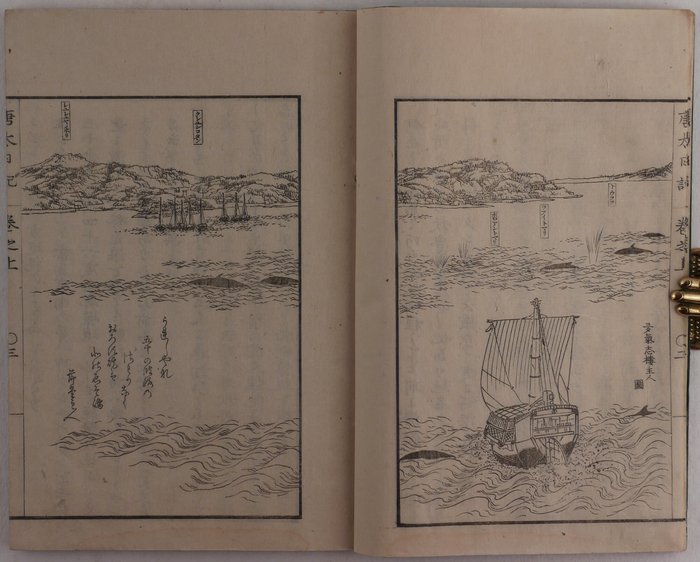
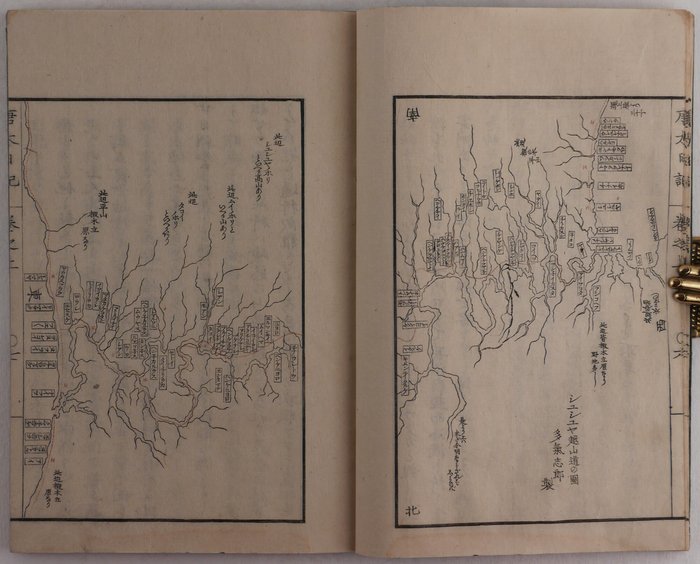
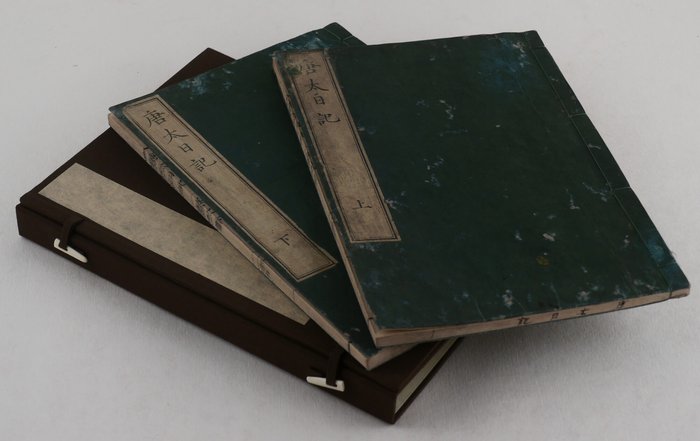
#O8
1860
First Edition. 2 vols. Quarto (ca. 25x17,5 cm). 28, 34 double-ply leaves; with 8 double-page and five single-page woodblock illustrations in text. Text and illustrations within single border, main text ten vertical lines. Illustrated by “Hashimoto Gyokurano ga”. Original Japanese fukuro toji bindings: green paper covers with leaves sewn together with strings and original paper title labels on the front covers. Several ink stamps on the title page and first and last leaves of both volumes, some partly removed (one names the owner “Ishikawa bunko”); large red ink stamp on verso of leaf 19 in volume 2. Housed in a later Japanese cloth folder with a paper label of a Japanese bookshop inside the upper cover. Covers and title labels slightly rubbed, otherwise a very good set.
Very Rare Japanese imprint with only six paper copies found in Worldcat. Interesting original account of a Japanese exploratory travel to the Southern Sakhalin Island at the time of its early colonization, both by Japan (in the south) and Russia (in the north). Shigenisa Suzuki, a Japanese official, went on a six-day trip from Kushunkotan village (modern-day Russian town of Korsakov, Aniva Bay) up the Susuya River and thence overland to the Naibutsu village (modern-day Ust-Dolinka) on the east coast of the island; he then crossed the island to the Maanui on the west coast, and returned home via Shiranushi – the southernmost Japanese settlement on Sakhalin, exactly across the Strait of Laperouse from Soya (Hokkaido). The book was edited and supplemented with commentaries by Matsuura Takeshiro Genkuwo, “a native of the province of Ise,” wro also travelled in the southern Sakhalin, in 1859 (Transactions and Proceedings of the Japan Society of London. Vol. IV. London, 1900, p. 21). The illustrations were done by prominent Japanese woodblock print artist Utagawa Sadahide “a senior pupil of Kunisada, <…> [who] produced many single-sheet prints and book illustrations. Sadahide is unquestionably the most gifted of the numerous Japanese artists who reported pictorially the crucial period of Western influence in the country's history” (British Museum online).
Suzuki gives vivid descriptions of the Ainu people of Sakhalin, their houses, manners and customs. He also briefly describes the remnants of the Russian post near the mouth of the Susuya River, known as fort Muravyovsky, the first Russian settlement on Sakhalin. Founded by a Russian navigator and explorer Gennady Nevelskoy on 21 September O.S./ 3 October N.S. 1853 on the site of the Ainu village Kushinkotan on the shore of the Salmon Inlet of the Aniva Bay, the fort was relocated to the mainland shore of the Strait of Tartary in May 1854 (i.e. A few months before Suzuki’s travel) due to the beginning of the Crimean War. It was rebuilt in 1869 under the name of fort Korsakovsky.
“A good general account of Sakhalin and its inhabitants, founded on the personal experiences of the two authors, whose journeys there were made at different times. Matsuura’s notes give the native Aino etymology of the place-names of Sakhalin” (Chamberlain, B.H. The Language, Mythology, and Geographical Nomenclature of Japan viewed in the Light of Aino Studies// Memoirs of the Literature College, Imperial University of Japan, No. 1. Tokyo, 1887, p. 160).
A list of illustrations:
1) Entering the Harbour of Kushinkotan (showing Mount Shushuya);
2) Map of the Shushuya Track;
3) The Great Fuki plant of North Yezo (Petasites sp.);
4) [Ainu water vessel?];
5) [Native plants of Sakhalin];
6) [Suzuki crossing a bridge made of a tree trunk, welcomed by the Ainus];
7) Sabuni exhibiting his treasures (Interior of a Sakhalin Ainu hut);
8) View of Naibutsu;
9) An Ainu family (the woman is tattooed round the mouth, one of the children is preparing a “Todo” (sea lion) skin, the husband is making “Yenawo,” who of which finished are shown on his right);
10) The Bay of Chikaberoshinai (the distant mountain on the left is Tosso-Nobori);
11) Kushun Ruver and Cape Yenrun;
12) Notoshamu, with Cape Kukke;
13) The Shrine of Benten (the Goddess Benzaiten) at Shiranushi (on the Horizon, from right to left are Todo Isle, Refunshiri and Rushiri, and Soya).
This is a rare first edition of the book, the second edition being published only in 2013 (Sapporo: Hokkaidō Shuppan Kikaku Sentā, 2013.) English translation was published in: The Twenty-Fourth Ordinary Meeting, December 11, 1895// Transactions and Proceedings of the Japan Society of London. Vol. IV. London, 1900, pp. 19-48.

